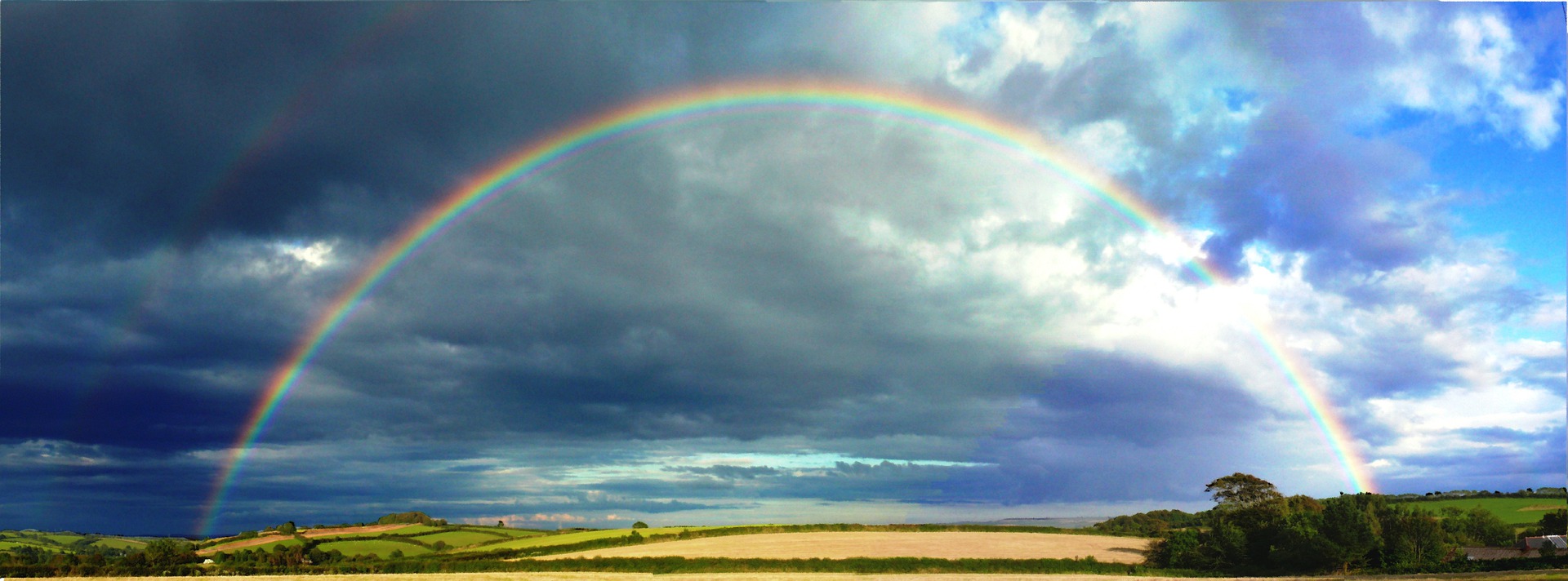The rainbow is probably one of the most beautiful natural phenomena to observe. It forms so beautifully colorful when several weather factors are met. We reveal impressive facts about the band of light.
A rainbow occurs when the sun shines, and it rains at the same time. They are an optical phenomenon and occur relatively frequently, to the delight of many.
They occur due to the reflection, refraction, and dispersion of sunlight interacting with raindrops!
Nevertheless, according to Huffington Post, there are many more things worth knowing regarding this phenomenon. To that end, here’s a list of fascinating facts you surely didn’t know:
- Not all colors of the rainbow are visible. – The rainbow encompasses a spectrum of colors ranging from red (outside) to purple (inside). Depending on the culture, it is believed to contain between three and nine colors.
In the West, it is generally believed that the rainbow includes seven colors red, orange, yellow, green, blue, turquoise, and violet. However, this is only a fraction of reality.
A rainbow contains an infinite amount of colors, or more precisely, lengths of light waves. Some of them are invisible to the human eye.
Others are too similar to neighboring colors and thus cannot be differentiated, which explains why our organ of sight recognizes only a small number of colors.
- Two people never see the same rainbow – Even if two people stand next to each other and look at the rainbow, they will never see the same one. Why? Because the raindrops through which sunlight falls are in constant motion.
In addition, their shape changes, creating a completely new angle of refraction. Depending on the position, the observer can perceive only a tiny part of the reflections.
The appearance of a rainbow is also influenced by the position of the sun, as well as that of the observer. It is also essential to consider visual ability, which varies significantly from person to person.
- The sky above the rainbow is darker than below it. – So far, only a few people have noticed it, although it is easy to recognize when you look at the rainbow. The sky above the rainbow is generally darker than inside it.
This is because each drop of water has a spherical shape that scatters light in a disc-like manner since it comprises a stack of colorful discs.
However, since the last discs contain other diameters, there is no superposition, which gives rise to the colors and shape of the rainbow.
Nonetheless, the discs overlap, creating white areas that make the sky appear lighter. Therefore, it seems less dark than above the rainbow.
- Rainbows at noon are very rare – For such a phenomenon to occur, several conditions must occur together: It must be raining while the sun is shining. But not only that!
Our Earth must be in a particular place: less than 42 degrees above the horizon. A rainbow occurs as soon as the sun’s rays hit the water drops at an angle less than or equal to 42 degrees.
The lower the sun is, the more visible the rainbow is. In contrast, the phenomenon does not occur or is barely visible when the Earth is firmly facing the sun.
Therefore, it is rare for a rainbow to appear at noon. The sun is too high at that time for all conditions to be met.
- A rainbow can also appear at night – How is it possible that a rainbow, which needs sunlight to appear, also seems at night? The answer: When the full moon takes the place of the sun.
The light emitted can graze raindrops or damp patches, like the sun’s rays, creating a similar colorful spectrum.
This phenomenon is called a moon rainbow and appears paler than the usual rainbow. Magical, isn’t it?
Its colors are the same as those of an ordinary rainbow, but due to the lack of light, they cannot be sufficiently detected by the receptors of the human eye.
Therefore, the phenomenon appears white more often at night. Furthermore, the night sky must be as straightforward as possible to perceive a lunar rainbow.
- It is impossible to reach the end – You can try to change your location or angle or ask another person in the distance; it is impossible to get to the back or base of a rainbow.
For the simple reason that the color rays that lead to the phenomenon depend on the distance and angle to the ground of the observer.
When you move, the rainbow moves with you and changes for all your neighbors, no matter how far away they are. However, legends persist that there is a treasure at the rainbow’s end.
- The arc can turn into a circle – A rainbow is a circle that forms around a certain point called the antisolar point. This is opposite to the sun; in fine weather, it is marked by the shadow that our head forms.
Yet we cannot see the circle because the Earth is in the way. The closer the sun is to the horizon, the larger the rainbow we see. At sunset, we know a semicircle.
In contrast, the higher the sun, the smaller the rainbow appears. However, as the observer increases in altitude and the sun is at his back, he can see more of the circle.
If you look down from an airplane, you may be able to spot the entire circle if you are lucky. However, this observation remains very difficult and rare.
- There are double and triple rainbows – Almost everyone has seen a rainbow at least once, but some are lucky enough to spot a double or triple rainbow.
Under certain circumstances, one rainbow can be accompanied by a second one that contains the colors in reverse order: Red on the outside and Violet on the inside.
This is due to the double reflection of light in the water droplets, but the second rainbow usually appears paler and less brilliant.
With triple reflection, you can even see a third rainbow. This has the same color sequence as the first but is even less visible.
So you can imagine how lucky the observer is to see a triple or even quadruple rainbow.
- You can make your rainbow in the garden – Our sky is far from the only place where a rainbow can be created. As soon as sun rays hit water drops, it is possible to replicate the phenomenon.
Perhaps you have also accidentally created a rainbow when watering your garden. To do this, you must face the sun with your back and a garden hose in your hand.
Then create a fine drizzle with the hose, and you have your rainbow. A rainbow can also appear in water fountains or waterfalls.
- You can make a rainbow disappear – This is possible by using your glasses. In fact, according to a Discover Magazine blog, glasses with polarizing lenses can make a rainbow disappear from your eyes, even though it’s still there.
To do this, all you need to do is hold the glasses vertically. This type of lens is designed to block polarized light, which is light that reflects off horizontal surfaces and typically causes glare.
The blocking allows only light that contains information to pass through the lenses. This is said to contribute to improved vision. The light that creates rainbows bounces back from water droplets and is also polarized.
The light is not filtered if you hold the glasses horizontally. But when you turn them, the lenses block the rays, making the phenomenon disappear. Simply incredible.
- Source: gentside.de/picture: Bild von PublicDomainPictures auf Pixabay
This post has already been read 1130 times!



